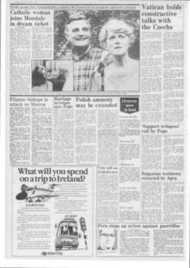Page 1, 20th July 1984
Page 1

Report an error
Noticed an error on this page?If you've noticed an error in this article please click here to report it.
Tags
Share
Related articles
Mary Rose Mass To Be Held In Ancient Rite
Mary Rose Funeral Query
Bishops' Engagements
Funeral Of Mgr. Thorman
Mystery Of Tiie Tomb Of St. Cuthbert In Durham
LAST RITES FOR THE MARY ROSE'S UNKNOWN SAILOR
MICHAEL SPREADBOROUGH, the cathedral carpenter at PortsmOuth's Anglican cathedral, keeps watch over the coffin he made for the burial on Thursday of the bones of one of the sailors from the Mary Rose, Henry VIII's flagship which went down with 700 crew in Portsmouth Sound on July 19, 1545.
The coffin of bones, a memorial to all who died, was laid to rest in the Navy Aisle of the Cathedral after a requiem mass using a Catholic rite current al the
time of the sinking. The remains of nearly 70 skeletons were discovered on the wreck.
In deciding on the manner of service the Cathedral authorities and their research historian, Mr Paul Fugler, had to bear in mind that, eleven years after Henry VIII's repudiation of papal authority, the Church was reformed in name but not in practice, especially in the liturgy.
The Mary Rose went down four years before the publication of the First Prayer Book, and the sailors were not what would now he described as Anglican.
The medieval Latin Sarum rite used on Thursday was therefore as accurate a version of the requiem the unknown sailor would have received in 1545, with a Mass composed by John Taverner, who died in the year of the sinking.
After the requiem, the coffin was moved from the sanctuary', receiving the final commendation from Canon Peter Doyle, Administrator of the Catholic
Cathedral, before being committed to the grave with the order from the Anglican Alternative Service Book.
The coffin, a small tudor box in oak, is caulked with black Stockholm pitch which was found in a cauldron on the wreck and, on boiling, turned out to be as usable as new.
The coffin was fixed with rosehead nails, and covered with a Welsh state plaque, recalling the association of the House of Tudor with Wales.
blog comments powered by Disqus










